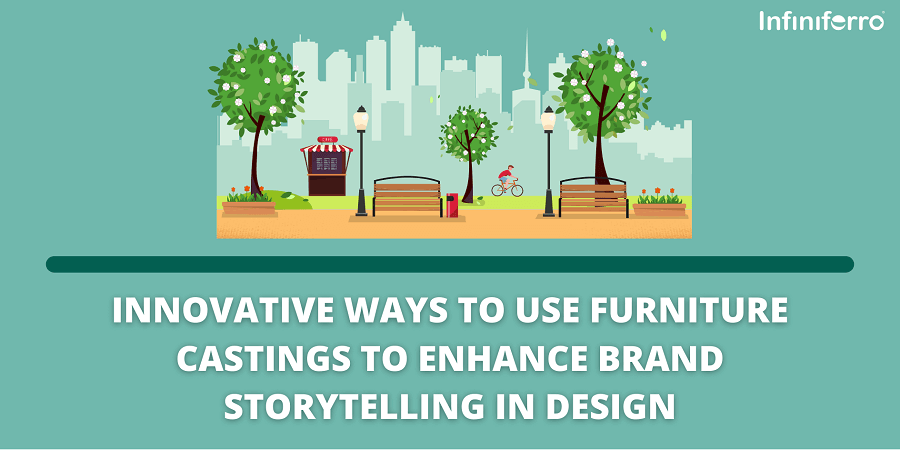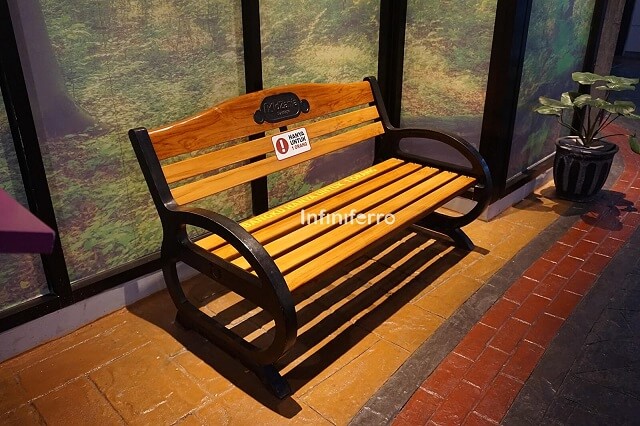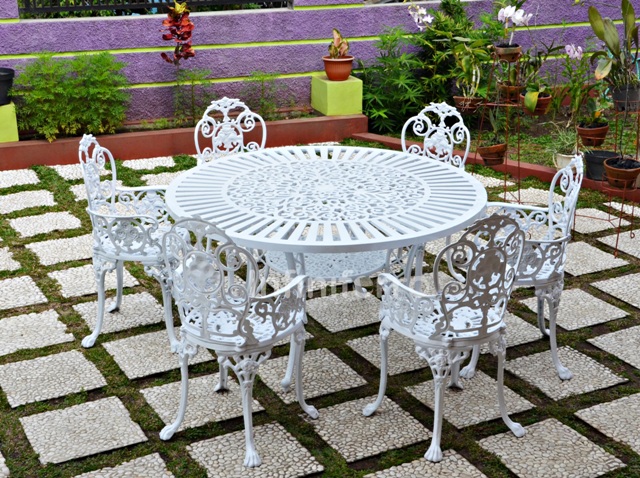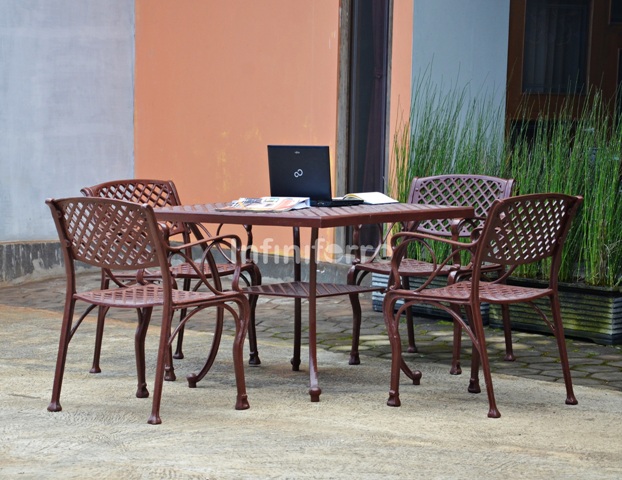
Even the slightest nuances are critical in designing organic interiors and developing compelling brand images. It is a pity, but in most cases, furniture castings can become rather valuable for developments that tell the brand’s story. These complex parts turn simple furniture into meaningful brand ambassadors and artifacts conveying brand values and narratives. Imagine an interior design consultant utilizing custom castings to create unique, memorable spaces that captivate clients.
This article unveils trends that apply to furniture castings to make your design unique while ensuring your brand story is exciting and unique. It is evident that when incorporating castings that depict a brand, a designer can create areas that appeal to customers emotionally. See how these small features make your idea come to life for the end-user and provide a unique brand experience for your business in the saturated market.
1. Understanding Furniture Castings: The Basics
Furniture castings are smaller parts made of metal, resin, or plaster, which add veins, curves, and other details to the furniture design. These basics are essential to know before delving into the radical concepts.
• Materials and Techniques
Furniture castings are available in different forms. The major ones include Metals casting in bronze or iron, which gives the furniture a durable and antique look that fits quite well in classic or industrial settings. Resin castings are flexible and resemble faux wood grain, stone, or metal. They are suitable for finely detailed areas with intricate details and lighter materials. Plaster castings must be more defined and ideal for antique or custom furniture embellishments. The precision of sand, investment, and die casts are crucial for developing these intricate parts within the manufacturing processes.
• Historical Significance
Originally, furniture castings were associated with a high-status representative of royalty or nobility. They often featured elaborate designs inspired by art movements like Baroque or Rococo. Today, these castings can give out traditional and hereditary looks or incorporate modern looks to make aesthetic statements in today’s architecture and design. This means that designers can add cultural heritage into furniture pieces, enriching the narratives behind the furniture.
2. Shaping a Unique Brand Image Through Custom Casting
The option of putting together furniture castings makes it possible to incorporate the brand personality in design. Designers can develop a consistent brand experience by utilizing logo-shaped casts and the overall atmosphere of a store or product.
• Logo Integration
Incorporating a brand’s logo in castings of furniture ensures that a brand message gently passes across subtly. This could, for instance, include a logo less than an inch in size on the legs of a chair, integrating it into the carving of a table, or using it as an ornament on the handles of cabinets. This way of placing chairs and furniture, in general, is highly functional, and the items themselves are reminders of the brand that offers them to clients and customers.
• Signature Patterns and Motifs
Working with casting specialists helps designers create more sophisticated patterns and designs that align with the brand story. These designs can come from different areas like history, the brand’s origin, culture, or USPs. For instance, a brand with a long history can use castings reminiscent of classic craftsmanship; in contrast, a brand that aligns with a modern approach to the company’s developments can incorporate castings that adhere to modernist design.
Such accouterments assure that all the furniture castings in question is both beautiful and meaningful as well as part of the brand – and thus the design story.

3. Enhancing Customer Experience through Sensory Design
Furniture castings positively impact the customer experience because they appeal to more than one of the senses. Such castings can also enhance the tactile and visual appeal of a space where people interact and help make an impact.
• Tactile Engagement
The texture of furniture castings plays a crucial role in tactile engagement, connecting customers to the brand on a physical level. For instance, properties such as smooth polished castings can help to deliver the luxury perception and refine the brand image.
On the other hand, coarse and uneven textures convey a sense of abrasiveness and authenticity for those brands that seek to showcase their more primitive, nature-inspired side. By carefully selecting the texture of castings, designers can associate certain feelings and other experiences, which is an essential and unique type of experience – the tactile experience of using furniture.
• Visual Appeal
Furniture castings involve fine works that enhance beauty and quality of view by the eye, leading to a focus on particular space areas. Specific carefully positioned castings may act as points for viewers’ attention and draw the focus on distinctive features of the brand narrative. For example, a meticulously executed cast on reception can leave an effective positive first impression that reminds clients of the brand.
Combining aesthetic brilliance with compelling narratives of brand storytelling, the designers guarantee that each piece of furniture casting contributes towards the brand’s story experience culture and results in a more enhanced and impactful consumer experience.
4. Sustainable Storytelling: Eco-Friendly Castings
Sustainability has become one of the focal areas of brand communication. Applying environmental management policies to develop furniture castings helps convey sustainability to the brand. This approach answers the modern customer needs for eco-friendly products and positively influences the brand’s image, making it more progressive and caring for the environment.
• Recycled Materials
Recycling materials in furniture castings is. Therefore, it is a good move to minimize our effect on the environment and make each piece of furniture look unique. Pigments & Coating: Manufacturers can recycle metals like aluminum or brass and reuse resins formulated from post-consumer waste. The practice is environmentally friendly to help conserve natural resources and tells a very appealing sustainability story.
In featuring these efforts to a large audience, brands may use such actions to communicate their stance on waste reduction and circular economy systems that many environmentally conscious individuals support.
• Sustainable Production Methods
Another good way of building up a brand’s green image is using sustainable production techniques. Some measures like closed-loop recycling take the waste back into production processes, and more efficient casting methods, such as low-pressure casting, can significantly reduce waste and energy used.
Moreover, renewable energy sources in production facilities can help reduce carbon emissions. Through such initiatives, these brands can design products that will capture environmentally aware customers. Such a commitment to sustainability sets the brand apart from similar brands in the market. It ensures that consumers seeking environmentally friendly products will likely be loyal to the brand.
Also Read:
- Creating a Cohesive Outdoor Living Space: Furniture Casting and Decking Design Tips
- Cast Iron Outdoor Furniture: Advantages, Designs, and Tips on Choosing It
- 3 Types of Metal That Are Often Used For Furniture
5. Evoking Emotion through Historical and Cultural References
Furniture castings are feelings inducers that incorporate elements of history and culture. In this way, this approach can strengthen the interaction between the brand and its audience through the sense of tradition and recalling the moments cherished by both the brand and the audience.
• Historical Replicas
Furniture designed to be a casting of an original piece or at least inspired by the past gives the space a timeless and genuine look. For instance, the casting elements that refer to Art Deco or Victorian motives will bring an idea of tradition.
Such car fakes recollect the earlier style and present the story of tradition and consistency. These two appeal to the target market that needs history in their environment, which supports the brand image of respecting history and adding to it.
• Cultural Inspirations
Proper saturation of furniture castings with cultural references and imagery enables those brands to develop authentic and compelling stories crucial for consumers’ identification. Thus, creating works that consume various cultural associations is possible, using elements of local crafts or universal logos. This approach effectively promotes the company’s ethnic sensitivity since it interfaces with diverse cultures that matter to consumers.
Regardless of whether it is native designs or the meaning behind symbols common to all people, cultural references introduce depth to the brand narrative, making them more attractive to most people. This approach aids brands in developing what one might effectively describe as an emotional connection with their target market based on elements of culture and stylistic conception.
6. Collaborating with Artisans for Unique Creations
Outsourcing with good artisans can make furniture castings that have no counterparts in the market a reality. These partnerships do not only serve the purpose of improving the quality of the furniture but also give a human face interminable to the brand narrative.
• Artisan Craftsmanship
It is possible to use artisans to finish complex parts and high-quality castings, which a mass production line cannot achieve. Designs have sophisticated patterns and often maintain traditional ornamentation since genuine artisans use the correct techniques and apply their craftsmanship to unique motifs and intricate work that ensure the brand’s adherence to high-quality standards and attention to detail.
Such an approach to production works as a unique custom at a whole level of exclusivity and conveys the idea of quality, which customers appreciate; at the same time, it gives the brand a competitive advantage, as opposed to similar brands that produce goods using the conveyor method.
• Storytelling through Collaboration
Emphasizing the context of stories related to cooperation with artisans can benefit the brand’s story and the client’s relationship. Explaining how the brand established the partnerships and the features of the work created by these artisans will help to disclose the brand’s focus on quality and genuineness. For instance, showing interviews with artisans in videos or glimpses of their workshop can add value to the brand’s narrative, as it focuses on supporting craftsmanship and using techniques passed down for generations.
This transparency generally enriches the brand’s identity and fosters trust and customers’ devotion due to the manufacturers’ willingness to portray individuals behind their labels.

7. Incorporating Modern Technology for Innovative Designs
Modern technology creates a new opportunity for making modern furniture castings more unique. Some procedures like 3D printing or CAD can take the design one step further and offer more intricate design solutions.
• 3D Printing
One of the significant innovations that have made furniture casting explode into making more intricate part designs on pieces of furniture is the 3D printing technology. This technology creates beautiful designs with accuracy and in a shorter time, allowing designers to exploit otherwise impossible ideas.
Interpretations also note that 3D printing designs offer the advantage of making rapid alteration and modification possible; thus, designers can change any piece to meet the brand standards or the designer’s vision. Therefore, it optimizes trial opportunities in new forms and textures to create unique furniture, hence the solutions.
• CAD and Digital Design
Computer-aided design (CAD) tools are vital for contemporary furniture design, as they offer a work environment that allows for the creation of accurate and intricate patterns. These tools will enable the designer to flesh out their vision and accurately determine the method by which they will realize it; in other words, designers make sure they painstakingly conceptualize each aspect before getting down to the actual manufacturing process. CAD software enables the inclusion of every aspect of branding in the pieces of the products and thus helps give them a look that is related to the brands.
Through CAD, the designers can work out different design aspects, experiment with practical applications, and look as they design before being put into production. As a result, it eliminates duplicate design solutions and strengthens the capacity to create flawless customized furniture in perfect compliance with the brand’s image.
8. Creating Immersive Brand Environments
Furniture castings have the potential to be vital in designing effective branding techniques to reach customer through their eyes, visually and physically. When applied in design, these elements help make branded spaces narrate coherent and engaging stories.
• Thematic Consistency
If furniture castings are to create a brand experience that impacts customers directly, then they need to fit the spatial theme. In a high-steel hotel, for example, the castings might contain the designs of the building and give the impression of the overall hotel. Similarly, a fancy restaurant can apply aggressive, current casts that underline exclusivity. At the same time, balancing these elements with the theme of the space also unifies the entire environment to convey the brand’s story.
Through such a thematic unity, the environment appears much more coherent and easy to recall; tangible associations with the brand’s narrative enrich the experience and tell stories through objects.
• Interactive Elements
Including interactivity in the furniture castings elevates the design’s functionality and purpose. For example, if the casting is in a handle, knob, or light, it adds a new twist and becomes special, turning the general into the specific. It also improves the furniture’s utility and gives the buyer a much more involved experience with the brand.
Ultimately, brands can make their environments much more vivid and inviting, whether they incorporate pieces designed for the touch or simply parts of the installation that the participant can manipulate in one way or another. It assists in further anchoring the brand into the place while making it a more pleasant and effective environment.
9. Case Studies: Successful Implementation of Furniture Castings
Examining case studies of successful implementation can provide inspiration and practical insights. These examples illustrate how furniture castings serve as distinct points of emphasis to the brand story of the select products.
• Luxury Hotels
Bespoke furniture castings are commonly used in luxury hotels to enhance guests’ experience by creating a hidden luxury. For example, in Paris at the Ritz-Carlton, you will find custom castings in the Parisian historic architectural styles with wrought iron detailing that complement the city’s aura. Such designs culminate in the aesthetic appeal of the environment and enable the guests to get lost in a story that tells the history of the place.
The integration of these castings helps to establish a unique sense of place and offers guests an experience that is both luxurious and deeply connected to its surroundings.
• Retail Spaces
In retailing, it is custom for furniture castings to be used in points of sale to help create ambiance and further enhance branding. Apparel stores such as Apple utilize furniture casting designs that are modern and minimalistic and include advanced technology aspects, as this is a slogan for the Apple store brand.
For instance, by inserting a combination of company logos on furniture pieces, like a handle or a showcase, consumers are kept interested throughout their shopping spree. This strategic use of castings can assist in smoothly integrating form functions to provide the customer with more tangible stories about the brand.
Future Outlook: The Role of Furniture Castings in Evolving Brand Storytelling
In the case of furniture castings, their potential role in the brand story is virtually limitless, as is the application of casting as a material in design. With increasing competition driving brands to seek novel ways to engage their clients, furniture castings will become even more relevant in design. Embracing custom designs, sustainability, and technological advancement can help fashion brands convey a positive and timeless story.
Using furniture castings is not only about decoration; it is about creating meaningful connections and unforgettable experiences. When considering these unique approaches in the utilization of furniture castings, it is essential to recognize that even the smallest detail can make a brand’s narrative stand out.


Leave a Reply